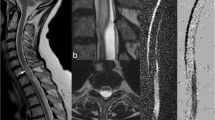Abstract
Heavily T2-weighted fluid-attenuated inversion recovery (FLAIR) sequences with inversion times of 2000–2500 ms and echo times of 130–200 ms were used to image the brain stem of a normal adult and five patients. These sequences produce high signal from many white matter tracts and display high lesion contrast. The corticospinal and parietopontine tracts, lateral and medial lemnisci, superior and inferior cerebellar peduncles, medial longitudinal fasciculi, thalamo-olivary tracts and the cuneate and gracile fasciculi gave high signal and were directly visualised. The oculomotor and trigeminal nerves were demonstrated within the brain stem. Lesions not seen with conventional T2-weighted spin echo sequences were seen with high contrast in patients with infarction, multiple sclerosis, sarcoidosis, shunt obstruction and metastatic tumour. The anatomical detail and high lesion contrast given by the FLAIR pulse sequence appear likely to be of value in diagnosis of disease in the brain stem.
Similar content being viewed by others
References
Ranson SW, Clark SL (1959) The anatomy of the nervous system, 20th edn. Saunders, Philadelphia
Truex RC, Carpenter MB (1969) Human neuroanatomy, 6th edn. Williams & Wilkins, Baltimore
Moyer KE (1980) Neuroanatomy. Harper and Row, New York
Flanigan BD, Bradley WG, Mazziotta JC, et al (1985) Magnetic resonance imaging of the brainstem: normal structure and basic functional anatomy. Radiology 154: 375–383
Bradley WG (1991) MR of the brainstem: a practical approach. Radiology 79: 319–332
Hirsch WL, Kemp SS, Martinez AJ, et al (1989) Anatomy of the brainstem: correlation of in vitro MR images with histologic sections. AJNR 10: 293–297
Curnes JT, Burger PC, Djang WT, Boyko OS (1988) MR imaging of compact white matter pathologies. AJNR 9: 1061–1068
Hennig J, Naureth A, Friedburgh H (1986) RARE imaging: a fast imaging method for clinical MR. Magn Reson Med 3: 823–833
Author information
Authors and Affiliations
Rights and permissions
About this article
Cite this article
De Coene, B., Hajnal, J.V., Pennock, J.M. et al. MRI of the brain stem using fluid attenuated inversion recivery pulse sequences. Neuroradiology 35, 327–331 (1993). https://doi.org/10.1007/BF00588360
Received:
Issue Date:
DOI: https://doi.org/10.1007/BF00588360




